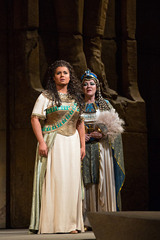| Opera Reviews | 19 April 2024 |
A conventional winnerby Steve Cohen |
|
| Verdi: Aida Metropolitan Opera December 2012 (HD performance) |
|
|
You could see the happiness in the faces of attendees at the cinema last weekend when the Met's Aida was beamed live in HD. Audiences loved the grand singing and the spectacle of horses leading a triumphal parade, massive columns, palm trees and an underground burial vault. Among the multitude of opera-lovers who are not part of the trendy set, I've seen a growing discontent with productions that violate the composer's intentions. The gap has grown between what Manhattan critics say is smart and what out-of-town audiences find enjoyable. Cinema patrons were bewildered when they saw Philip Glass's Satyagraha despite the fact that aficionados told them it was a masterpiece. I loved the music but agreed with audience frustration at the indecipherable Sanskrit libretto for which the company refused to show translated captions. The disparity was even greater with The Tempest this November. London and New York critics wrote that Thomas Adès had composed a masterpiece, yet folks in the hinterlands hated it. With familiar operas, like Tosca, patrons wonder why they no longer are allowed to see reproductions of the church of Sant'Andrea della Valle or the Castel Sant'Angelo that Puccini specified. And with the Ring, why have the realistic sets that Wagner called for - and which were replicated at the Met from 1989 to 2009 - been scrapped and replaced with high-concept, high-tech rotating planks. I repeatedly hear patrons complain that the composers' intentions are being subverted by designers and directors who try to be trendy. A modern-dress version of Aida was produced by Disney on Broadway, but most opera-lovers still want to see the grandiose evocations of ancient Egypt that Verdi had in mind. So Sonja Frisell's 1988 production, with hundreds of people and five horses onstage in the triumphal scene, was a pleasure to see. TV director Gary Halvorson used many camera angles reminiscent of Busby Berkeley, showing the massive formations from above, as well as from ground level. It made for an exciting show. The last scene was especially impressive, with the set on elevators and the lovers trapped on a lower level while Amneris stood over their tomb on an upper level. The appearance of the singers also was old fashioned. Ukrainian soprano Liudmyla Monastyrska, in the title role, has a roundish face and full figure. Olga Borodina, as Amneris, is a mature woman with a plain face. Roberto Alagna, the Radames, has been called a cutie-pie (web fans refer to him as Bobby Baby) but he obviously is in his late forties. No one can accuse the Met this time of choosing cast members for their looks. And that's fine. Monastyrska has a real Verdi voice with nice warm tone, a secure high C and ample power to soar over massed crowd scenes. Borodina also is a fine singer who sounded exciting, although she lost control of some of her high notes in the Judgement scene. George Gagnidze made a strong Amonosro, intimidating and unsubtle. Alagna sang the Egyptian commander Radames in an unusual way, emphasizing the lyrical part of his character rather than the martial. Celeste Aida, as we know, ends on a high B-flat which the composer asked to be sung pianissimo and morendo ("dying off"). Most tenors hit the note forte and very few of them are able to diminish it in progress. (Carlo Bergonzi was the best at that.) Arturo Toscanini set a precedent when he allowed Richard Tucker to sing the note forte, then drop an octave and repeat it pianissimo on the lower B-flat. Here, Alagna sang a very soft high note which came out breathy and, after that, descended an octave to repeat it quietly. What's the point of taking the repeat if both times you're whispering? Through the rest of the opera he maintained a vibrant tone. His dramatic phrases in the Nile scene were ringing, although his best singing was in the quieter pages of the Tomb scene. As usual, his acting was appealing. Fabio Luisi conducted more effectively here than he did with Un Ballo in Maschera. He handled the huge ensembles with aplomb and was sensitive to each singer while not allowing unbridled license. |
|
| Text ©
Steve Cohen Photo © Marty Sohl / Metropolitan Opera |

 At
last, we have a winner!
At
last, we have a winner!





